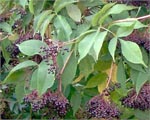 |
|
Species: Elderberry, Sambucus sp.
Family: Caprifoliaceae
Class: Dicotylen
Order: Angiosperms
Kingdom: Plants |
|
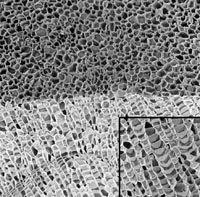 |
| Scanning electron microscopy of cork |
Cork originates from a layer of
cambium (=phellogen) that itself is formed as a secondary meristem from a layer of
collenchyma or parenchyma immediately beneath the epidermis. In contrast to sclerenchyma cells, collenchyma cells are alive and they have retained the potency to de-differentiate. Cork cambium cells only divide periclinally so that the typical rows of daughter cells arise:
cork cells (=phellem) are mainly generated toward the outside. In a lesser extent also
cork parenchyma (=phelloderm) is made toward the inside. Cork cambium, cork cells and cork parenchyma together are also named
periderm. Mature cork cells are dead; their cell walls contain
suberine, a fatty substance that repels water. The layer of cork provides protection against desiccation, but it also isolates tissues in the inner parts of the stem or trunk so thoroughly that exchange of gas with the outer world is impeded. 'Breathing' is yet achieved by so-called
lenticels. The cork cambium starts to generate numerous parenchyma cells toward the surface, in most cases at the level of a stoma. These thin-walled parenchyma cells, which eventually degenerate, force an interruption of the sealing created by the cork layer and focus an opening for gas-exchange.
| Cork formation - Example: elderberry |
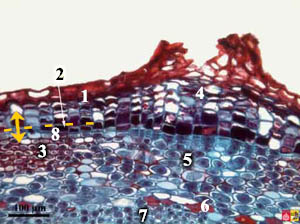 |
![Gebied kurkvorming in de stengel van de vlier][Region of cork formation in elderberry stem]](/images/stemgrowth/SGPL0263-OverviewCorkSambucus.jpg) |
| Onset of cork formation from cork cambium: 1 cork = phellem; 2 cork cambium = phellogen; 3 collenchyma; 4 lenticel; 5 parenchyma; 6 sclerenchyma; 7 phloem; 8 cork cortex = phelloderm |
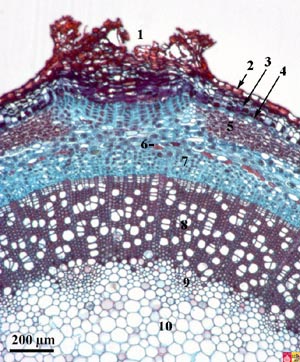 |
Continuation of cork formation: 1 lenticel; 2 epidermis; 3 cork; 4 cambium; 5 collenchyma; 6 sclerenchyma; 7 phloem; 8 secondary xylem; 9 primary xylem; 10 pith
|
| Lenticel formation - Example: castor bean |
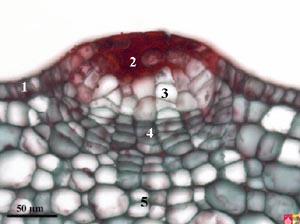 |
Young stage of lenticel formation: 1 epidermis; 2 lenticel; 3 parenchyma; 4 cambium; 5 phelloderm |